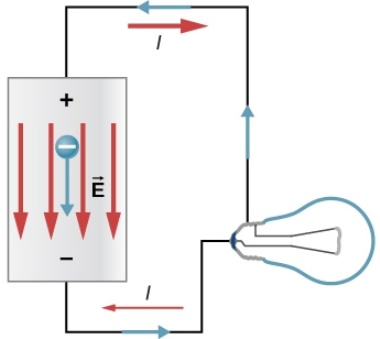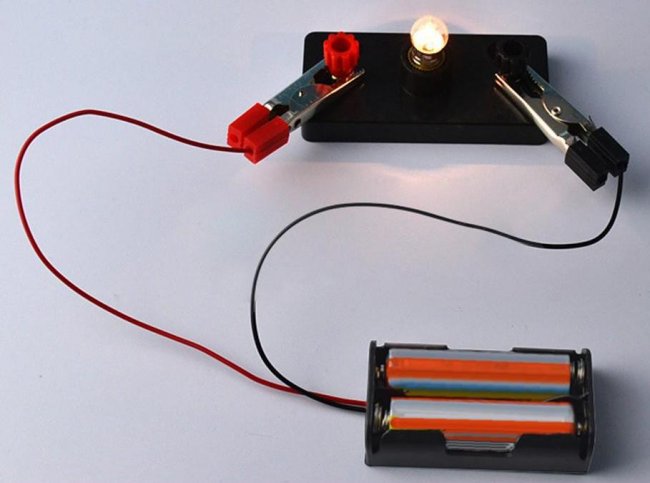EMF source with closed external circuit
The reason for the separation of charges and causing them to move in a closed circuit is called the electromotive force (emf, emf).
The EMF value of any source in which charge separation occurs is estimated from the work expended by the field to move a unit charge from an electrode of lower potential to an electrode of higher potential.
In accordance with the definition of potential, this work is equal to the potential difference of the separated charges, which, like the cause separating the charges, is called electromotive force.
If the source clamps are connected to a conductive body and thus create a closed circuit, then it will be established electricity, whose direction coincides in the external circuit with the direction of the EMF. Inside the source, charge separation is taking place all the time and the potential difference is maintained.

The movement of charged particles in the presence of a current has the same direction throughout the closed circuit, and the work expended by the field to move a unit charge along a closed circuit can be estimated with a value that is also equal to the work of the forces inside the sources that move a unit charge from the negative electrode to the positive electrode relative to the forces electric field.
In a direct electric current, the charges concentrated on the electrodes of the source are continuously restored, and the field around the electrodes caused by these charges has the same character as in an open external circuit: it is potential. In contrast to the electrostatic field of continuously regenerated charges, it is called a stationary field.
A stationary field differs from an electrostatic field not only in that the charge of the source of this field is constantly restored, but also in that such a field is located both around conducting bodies and inside these bodies. For a stationary field that has the same character as a potential field, for any closed loop that does not pass through an EMF source.
Referring to the hydrodynamic analogy in the case of a closed external circuit of the EMF source, we must imagine the operation of the hydraulic system with an open drain pipe, in which, let's say, there is a certain receiver (hydraulic motor). To maintain a constant level difference between the tanks, the pump must replenish the amount of liquid in the upper tank that flows through the drain pipe.
The work expended by the engine to raise this amount of liquid is proportional to the difference in levels and can be characterized by the value of this difference. The work done by the fluid flow in falling from the upper level to the lower level is proportional to the same difference in levels and, if no loss is allowed, is equal to the work done by the engine.
The electromotive force in a number of sources is practically independent of the value of the electric current in the circuit, which is why it is often assumed that it remains the same both during idling of the source and at full load. However, as a rule, the EMF during charging of the source is slightly different from the EMF value during idling (usually less).
The change in EMF in this case is explained by the so-called source reaction. For example, in chemical EMF sources its decrease is observed in connection with the phenomenon of polarization, in electrical machine generators — due to the imposition of a load current directed in the opposite direction to the magnetic field on the magnetic field.
The potential difference between individual points in an electrical circuit depends on the distribution of voltage along the circuit. In particular, the potential difference between the source terminals depends on the ratio between the external and internal resistance of the source, or the so-called internal voltage drop.
The electromotive force can be concentrated on an extremely limited section of the electrical circuit in a jump (which, for example, occurs in galvanic, thermoelectric, and also in other sources where the EMF arises at the points of contact of different substances) or distributed over some part of the internal source circuit.
We meet the latter case in electric machine generators, where an emf is induced over a considerable length of wires as they move in a magnetic field, and the total emf is the sum of the elementary emfs induced in individual sections of the circuit. The sum of these values is equal to the potential difference between the beginning and end of the wires.
In the analysis and calculation of electrical circuits containing EMF, it is often assumed that the EMF is concentrated in nature. The presence of internal resistance of the source is taken into account by introducing an additional on-resistance.
Since EMF characterizes the transformation of one or another type of energy into electrical energy during the passage of current, when talking about sources of EMF or current, the term "source of (electrical) energy" is also used. All these terms are synonymous when it comes to the actual sources.
Sometimes when they calculate and analyze electrical circuits, they make a difference current sources and EMF sources.
A source of EMF is understood as such a source of energy, the EMF of which can be considered independent of the value of the internal resistance, and the EMF of such a source must tend to infinity. Sometimes this is achieved through schematic solutions, use of stabilizing devices, etc.



